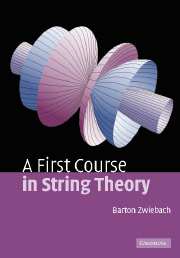Book contents
- Frontmatter
- Contents
- Foreword
- Preface
- Acknowledgements
- Part I Basics
- Part II Developments
- 14 D-branes and gauge fields
- 15 String charge, electric charge, and particle physics
- 16 String thermodynamics and black holes
- 17 T-duality of closed strings
- 18 T-duality of open strings
- 19 Electromagnetic fields on D-branes
- 20 Nonlinear and Born–Infeld electrodynamics
- 21 Covariant string quantization
- 22 String interactions and Riemann surfaces
- 23 Loop amplitudes in string theory
- References
- Index
21 - Covariant string quantization
from Part II - Developments
- Frontmatter
- Contents
- Foreword
- Preface
- Acknowledgements
- Part I Basics
- Part II Developments
- 14 D-branes and gauge fields
- 15 String charge, electric charge, and particle physics
- 16 String thermodynamics and black holes
- 17 T-duality of closed strings
- 18 T-duality of open strings
- 19 Electromagnetic fields on D-branes
- 20 Nonlinear and Born–Infeld electrodynamics
- 21 Covariant string quantization
- 22 String interactions and Riemann surfaces
- 23 Loop amplitudes in string theory
- References
- Index
Summary
In the Lorentz covariant quantization of string theory we treat all string coordinates Xμ(τ, σ) on the same footing. To select physical states we use the constraints generated by a subset of the Virasoro operators. The states automatically carry time labels, so the Hamiltonian does not generate time evolution. We describe the Polyakov string action and show that it is classically equivalent to the Nambu–Goto action.
Introduction
In this book, the quantization of strings was carried out using light-cone coordinates and the light-cone gauge. String theory is a Lorentz invariant theory, but Lorentz symmetry is not manifest in the light-cone quantum theory. Indeed, the choice of a particular coordinate X+ for special treatment hides from plain view the Lorentz symmetry of the theory. While hidden, the Lorentz symmetry is still a symmetry of the quantum theory, as we demonstrated by the construction of the Lorentz generator M−I. This generator has the expected properties when the spacetime has the critical dimension.
Since Lorentz symmetry is of central importance, it is natural to ask if we can quantize strings preserving manifest Lorentz invariance. It is indeed possible to do so. The Lorentz covariant quantization has some advantages over the light-cone quantization. Our light-cone quantization of open strings did not apply to D0-branes because the light-cone gauge requires that at least one spatial open string coordinate have Neumann boundary conditions. Covariant quantization applies to D0-branes.
- Type
- Chapter
- Information
- A First Course in String Theory , pp. 459 - 480Publisher: Cambridge University PressPrint publication year: 2004



